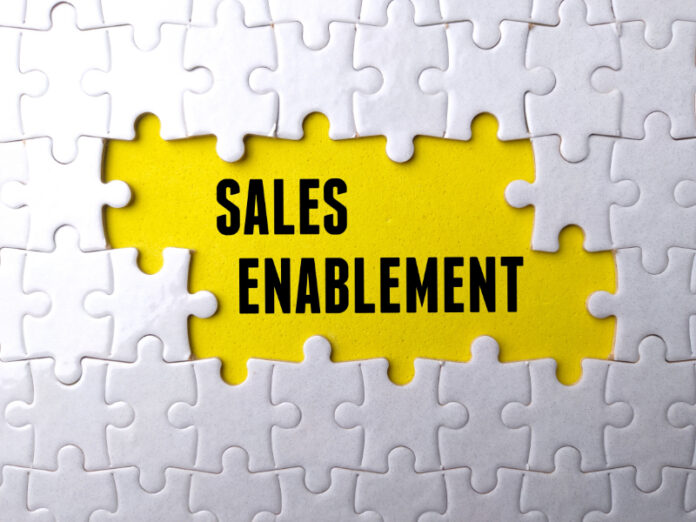Sales enablement is not just for the sales team, writes Laura Valerio, Principle Consultant EMEA at Highspot.
‘Sales enablement’ is a fairly new concept in the UK, though its practice has grown rapidly in recent years as businesses have started to look for ways to improve efficiency and increase revenue during challenging economic times.
Despite its growth, the function is still somewhat misunderstood. It’s not uncommon for people to assume that sales enablement only benefits salespeople – it is called sales enablement after all. However its true role is to empower all customer facing teams with the right knowledge, tools and data they need to achieve their targets consistently. And one key pillar of its mission is to align sales with other areas of the business, such as marketing and operations, broadening the benefits across multiple departments in a business and ultimately, improving productivity.
In order to clear up some of this confusion, we need to unravel the myths surrounding sales enablement so leaders everywhere can understand its real function in their business.
It’s not just for sales
A common misconception about sales enablement is that it’s only there to benefit and support the sales function of the business.
If that was true in the early stages of the function, its scope has now expanded. To reflect the change, its name is evolving from ‘Sales Enablement’ to ‘Revenue Enablement’.
A modern Enablement function is in fact a centralised intelligent orchestration of all initiatives, processes and tools that empower customer-facing people to be consistently successful and win the market.
Business functions tend to work separately, and each has its own language. Despite their good intentions, this doesn’t always translate perfectly across teams and leads to misinformed, overwhelmed, frustrated customer-facing colleagues.
It’s the sales enablement role that curates and translates this department-specific vocabulary and makes it easy to digest for the customer-facing teams, resulting in consistent well-informed messaging and ultimately happier prospects.
In times of economic uncertainty and geo-political unrest, businesses and especially go-to-market teams need to quickly find new ways to manage, adapt and embrace change, be ahead of the curve, anticipating new customers’ needs and behaviours. By bridging teams and streamlining processes, Enablement also impacts how quickly key business milestones are met.
It’s not just another supporting function
In uncertain times, it comes down to thinking about how businesses can do more with less. For leaders, this is measured in profitable growth and scalability.
Having one strategic function, such as sales enablement, that streamlines multiple functions to work more efficiently is critical. Business leaders can boost productivity, by developing highly cross-collaborative teams resulting in effectively achieving shared company goals.
Enablement doesn’t just impact the way salespeople work, but when you have good alignment between sales, marketing and operations you can obtain the data to really understand what is working well in your business, and on the flip side, what isn’t working well. This added value allows you to quickly replicate the successes of your teams, whilst highlighting areas for improvement.
Insights lead to meaningful action, and added value isn’t something businesses can afford to ignore.
It’s not just about improving efficiency
The added value of implementing a sales enablement technology accelerates productivity and efficiency across the workforce. Having sales enablement as a core function will help businesses not just survive the current economic headwinds but thrive.
With 67% of UK sales and marketing identifying the cost of living crisis as one of the issues likely to have the greatest impact on their KPIs over the next year. Businesses should be looking to do whatever they can to support both of these key business functions.
This can be done by making each sales rep more efficient by giving them time back via content management and simplified curated comms from the rest of the business. Consequently, this allows them to spend more time talking to potential prospects, upskill themselves and ultimately achieving targets quicker.
Enablement technology helps you operationalise your strategy, make decisions faster and quickly understand through real-time data and insights what you need to do next in order to improve velocity in execution. Sales enablement professionals work with other functions across the business to assist go-to-market teams on how they can get from point A to point B, using the insights the technology provides.
The secret to productivity is enablement. It helps improve efficiencies across the organisation, helping the business to make decisions faster and leaders to forecast better.
Forget the myths, try the reality
There’s a lot of businesses that still need to learn about sales enablement and how it can help their teams and their bottom line, but progress is being made. In fact, in our latest report, we found that 72% of sales and marketers already agree that implementing sales enablement is something they believe their company should consider in the near future.
It’s important to clear up the misconceptions about sales enablement that hold businesses back from taking the leap to try it as, increasingly challenging times, there’s no better tool for a modern business. Organisations with enablement achieve a 49% win rate on forecasted deals, compared to 42.5% for those without. Strategic enablement equips your sales teams with the resources, training and coaching they need to improve customer interactions, promptly deliver value and predictably win more deals – making it a critical function for businesses to drive top-line results, faster.
Highspot is the sales enablement platform that increases the performance of sales teams by bridging the gap between strategy and execution. Companies like DocuSign, Siemens, Nasdaq, Okta, Red Hat and Zillow use Highspot to manage content, train and coach sellers and engage buyers. Executing strategic initiatives with Highspot increases revenue, drives consistent rep performance and improves rep ROI.
More details about Highspot can be found here.


